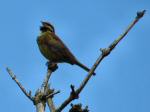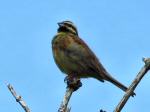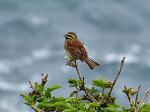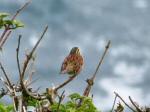Latin name: Emberiza cirlus
Once widespread in southern England the Cirl Bunting declined rapidly
to just 118 pairs in 1989 but thanks to dedicated conservation efforts
numbers have now increased to approximately 862 pairs. They are now confined
to south-west England, mainly in south Devon; near to the coast although
a small breeding population has been re-introduced in south Cornwall.
However the Cirl Bunting remains the UK's rarest farmland bird species
and one of the country's most threatened songbirds. It is a close relative
of the Yellowhammer; the male has a yellow head, a black crown, eye stripe
and throat, yellow under-parts and a grey-green chest-band, and a chestnut
back. The female and young are much more inconspicuous, brown and buff
with a streaked grey-brown rump and chestnut shoulders. It is an all year
around resident, rarely moving more than a mile from its place of birth.
Their ideal habitat is a mixture of grass and arable fields, divided by
thick hedgerows with pockets of dense scrub such as blackthorn, hawthorn,
bramble and gorse. They nest on the ground within this dense scrub raising
2 or 3 broods from April until mid-September. Their diet consists of both
insects and seeds.
|















